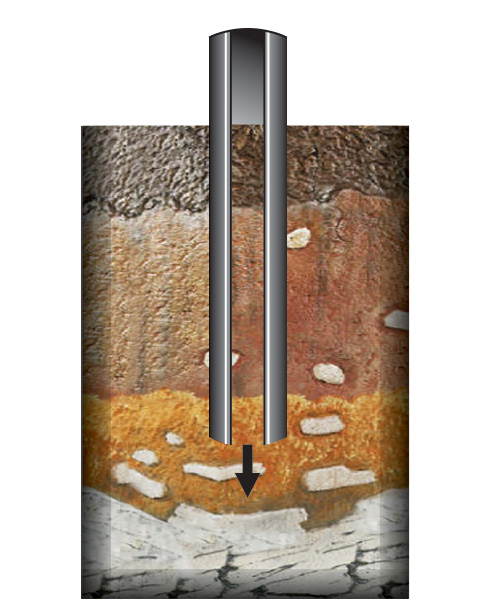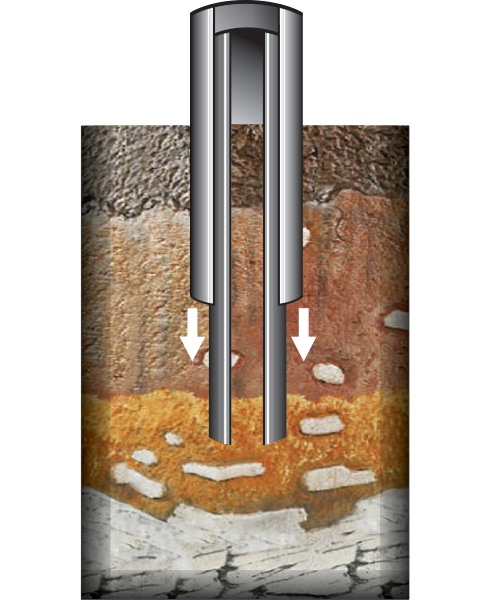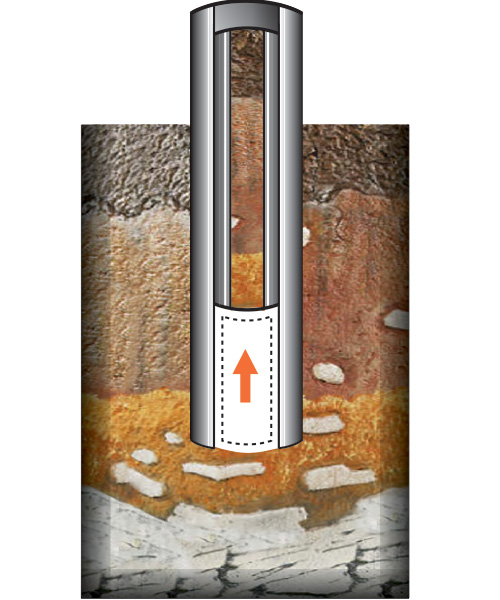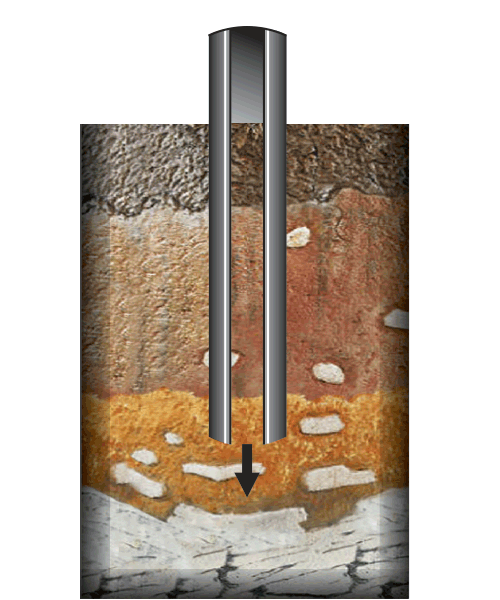NON MINIER
26 février 2017
Comment fonctionne le forage sonique
Cette histoire a été publiée à l'origine dans GeoDrilling International le 19 mars 2019
Sonic Drilling
Sonic est une forme de forage avancée qui utilise l’énergie de résonance haute fréquence générée à l’intérieur de la tête Sonic pour faire avancer un carottier ou un carter dans des formations souterraines. Pendant le forage, l’énergie de résonance est transférée dans le train de tiges à la face du trépan à diverses fréquences Sonic. La rotation simultanée du train de tiges répartit uniformément l'énergie et l'impact au niveau de la face du trépan.
L'énergie de résonance est générée à l'intérieur de la tête Sonic par deux poids à contre-rotation. Un système d'isolation pneumatique à l'intérieur de la tête Sonic empêche la transmission de l'énergie résonnante à l'appareil de forage et dirige de préférence l'énergie vers le train de tiges.
Le foreur contrôle l'énergie de résonance générée par l'oscillateur de la tête Sonic afin de l'adapter à la formation rencontrée afin d'obtenir une productivité de forage maximale. Une résonance se produit lorsque l’énergie sonique résonnante coïncide avec la fréquence naturelle du train de tiges. Cela se traduit par la quantité maximale d'énergie livrée au visage. Dans le même temps, le frottement du sol immédiatement adjacent à l'ensemble du train de forage est sensiblement minimisé, ce qui entraîne des taux de pénétration rapides.
La procédure de forage sonique
Bien qu'il existe plusieurs façons de forer avec Sonic (en fonction des conditions spécifiques du site et des objectifs du projet), le moyen le plus courant consiste à faire avancer un carottier, qui est remplacé par un train de tailleur de plus grand diamètre qui recouvre le trou de forage ouvert et empêche son effondrement.
Diagramme d'oscillateur sonique
ÉTAPE 1: AVANCEMENT DU BARIL DE BASE
Le noyau est avancé en utilisant des fréquences sonores. Si nécessaire, cette étape peut être effectuée sans fluide, air ou boue.


ÉTAPE 2: RUPTURE DE BOÎTIER
Une fois que le carottier est en place, le tubage est avancé par voie acoustique sur le carottier, protégeant ainsi l’intégrité du trou de forage dans un sol meuble non consolidé.
ÉTAPE 3: RÉCUPÉRATION DE BASE
Le carottier est récupéré, produisant un échantillon relativement non perturbé avec une récupération du cœur proche de 100%.


ÉTAPE 4 - RÉPÉTITION DE L'AVANCEMENT DE BASE
Les étapes 1 à 3 sont répétées jusqu'à la profondeur, produisant un échantillon central continu au travers de formations non consolidées avec un écart inférieur à 1%.
Besoin d'en savoir plus sur le forage sonique? En savoir plus sur le LS250 MiniSonic
DISCUSSION
-
https://geo.hosting/vps/vps-europe/vps-croatia
-
Looking for a hassle-free transfer? Our Owen Sound Airport Transfer Service provides quick, reliable shuttles from Owen Sound to Toronto Pearson, Buffalo, Kitchener, and Hamilton airports. We offer affordable taxis, luxury limo services, and private transfers for all your airport travel needs, ensuring you travel comfortably.
-
Un antrenor alergare montană еste ideal pentru ɑ te ghida în primii pașі șі a te ajuta să dezvolțі tehnici sigure.
-
Pregătirea cu ᥙn antrenor alergare îțі va permite ѕă abordezi trasee dificile șі să tе pregătești pentru competițіi montane.
-
Cum să îțі îmbunătățești rezistențа în alergarea montană Rezistența eѕte esențială în alergarea montană șі se dezvoltă prin antrenamente bine structurate.
-
https://pq.hosting/vps-vds-norway-oslo
-
Инструкция по установке VPN В современном мире, где интернет занимает существенное место в нашей жизни, вопросы безопасности и конфиденциальности в сети становятся особенно актуальными. VPN (виртуальная частная сеть) предоставляет эффективные средства для защиты вашей интернет-активности и сохранения конфиденциальности данных. В данной инструкции рассмотрим процесс создания собственного VPN. Для этого я выбрал услуги хостинговой компании PQ.Hosting. Почему PQ.Hosting? Первое, что мне понравилось на сайте компании, именно в разделе VPN, это возможность поддержки разных устройств с одновременным подключением до 10 активных устройств на одну подписку. Пользователям, у которых есть желание подключить ВПН не только на компьютере, но еще и смартфоне, планшете, телевизоре (а таких сейчас большинство) это очень хорошее решение. Не в последнюю очередь обращаем внимание на технологию шифрования. Сегодня это очень важно! Ну и, конечно же, не менее привлекателен безлимитный трафик. Серфинг без ограничений по трафику и скорости, обеспечивающий полную свободу и комфорт в интернете лично для меня в приоритете. Кому нужен надежный ВПН? Дальше приведу категории пользователей, которым обязательно необходим надежный ВПН: Геймеры. Игроки могут использовать VPN для снижения задержек (пинга) в играх или для доступа к играм и контенту, недоступным в их регионе; Туристы. Люди, находящиеся за границей, могут использовать VPN для доступа к своим обычным интернет-ресурсам, таким как банковские аккаунты или любимые стриминговые сервисы. Компаниям. Сотрудники компаний могут использовать VPN для безопасного доступа к внутренним ресурсам и системам компании из удаленных мест; Обычным интернет-пользователям. ВПН будет полезен всем тем, кто ценит свою конфиденциальность и хочет защитить свои данные. А теперь переходим собственно к инструкции. Разворачиваем собственный VPN Дальше расскажу, какие преимущества несёт создание собственного VPN: Защита трафика. Ни администраторы Wi-Fi-сети, ни злоумышленники не смогут получить доступ к вашим данным. Доступ к заблокированным ресурсам. Поскольку сервер VPN расположен за пределами страны, вы сможете обходить блокировки на сайты и сервисы. Защита от слежки со стороны интернет-провайдеров. Использование VPN поможет вам обеспечить дополнительную безопасность Для простых задач, таких как серфинг в интернете или использование социальных сетей, VPN очень даже пригоден. Осталось разобраться, как настроить собственный ВПН. Инструкция по настройке VPN на примере PQ.Hosting Чтобы развернуть VPN, необходимо: 1. Арендовать VPS-сервер. Выберите одну из локаций на сайте https://pq.hosting/buy-tunnel 2. Дальше для настройки VPN-соединения используем Amnezia. Скачиваем приложение AmneziaVPN с официального сайта https://amnezia.org/ru/. 3. На почту, указанную при заказе сервера, придет письмо от хостинг-провайдера В письме должны быть указаны IP, User name или User ID, и Password, они понадобятся для установки VPN на сервер. 4. Запустите приложение AmneziaVPN 5. На первом экране выберете “У меня есть данные для подключения”, далее “Настроить свой сервер”, и внесите данные из письма. 6. Нажмите “Продолжить” и следуйте подсказкам приложения. В заключении скажу, VPN может быть полезен как для индивидуальных пользователей, так и для организаций, стремящихся обеспечить безопасность и конфиденциальность своих данных. Создание собственного VPN на базе Amnezia дает полный контроль над вашей сетью и обеспечивает защиту ваших данных. Следуя пошаговой инструкции, вы можете создать свой собственный VPN и наслаждаться безопасным и приватным интернет-соединением.
-
watch our most viewed neerfit hindi sexy video on your fingertips.
-
Our Airport Shuttle Houston to Galveston offers convenient transportation to the Galveston Cruise Terminal and other popular destinations. Enjoy reliable service from Houston Hobby and George Bush Airports, including connections to Kemah Boardwalk, Downtown Houston, and Clear Lake. Book your shuttle today!
-
https://www.credly.com/users/xerxes-howard
-
Make travel effortless with Winnipeg Airport Transfers, providing round-the-clock shuttles, taxis, and limos. From airport pickups to special events, we deliver reliable and comfortable service tailored to your needs.
-
Experience convenient travel with our Airport Shuttle Houston to Galveston. We provide timely shuttles to the Galveston Cruise Terminal, Kemah Boardwalk, and more. Reliable service from both Hobby and George Bush Airports ensures a smooth journey to Texas City and Baytown.




